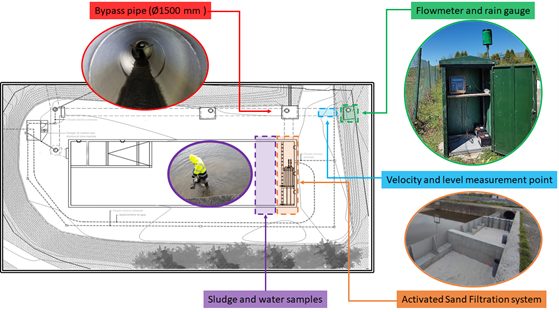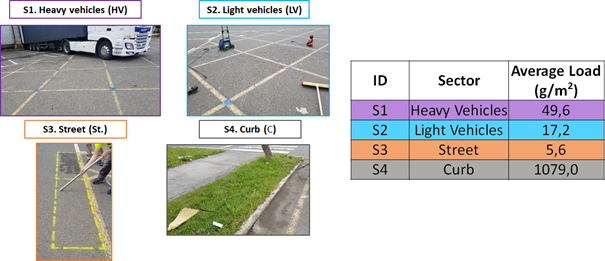As part of the monitoring strategies for diffuse pollution control within WP2, the GEAMA research group from the University of A Coruña (UDC) has implemented a system to study the behavior of the studied catchment in the Sionlla industrial park. As part of this initiative, a flow meter has been installed on the outlet pipe of the active filtration unit, tasked with recording data on treated flows from the detention-sedimentation pond, as well as diverted flows, enabling a detailed analysis of the catchment behavior and the flow that is sent through the stormwater drainage network.
The initial data has identified an approximate infiltration flow of 13 L/s. Additionally, the rating curve for this pipe section has been estimated, a key parameter to understand the relationship between water level and flow discharges. To complement this equipment, a rain gauge has been installed with the aim of performing rainfall-runoff transformation analysis, which has allowed the estimation of the catchment concentration time, calculated at approximately 15-20 minutes.
Understanding the catchment hydrographs is essential for accurately characterizing the inflow pollutographs into the detention-sedimentation pond. This will enable the establishment of sampling intervals for the inflows entering the filtration units. Additionally, to begin understanding the particle size distribution of those that might reach the filters, samples have been taken, and the sediments deposited at the downstream end of the pond have been characterized. Furthermore, a chemical analysis of the infiltration flow has been conducted, including the detection of basic parameters like temperature (17°C), pH (6.8), turbidity (3.8 UFT), alcalinity (22 mg/L CaCO3), DO (8.1 mg/L), conductivity (152 μS/cm), and the presence of Escherichia coli (500-524 ufc/100 ml).
The monitoring sections in the pilot unit are shown in Figure 1

Figure 1. Control points within the active filtration pilot unit. Sionlla industrial park.
In parallel, the first field campaigns have already been carried out in the Tambre industrial park, focusing on the characterization of road-deposited sediment (RDS) on Ptolomeo Street, which will be treated by a biofiltration unit. Four sectors with different accumulation dynamics were identified: the heavy vehicle parking area, where transport trucks gather for unloading goods in warehouses; the light vehicle parking area, typically occupied by passenger transport vehicles; the roadway, where vehicles circulate; and the curb, which collects and accumulates materials from both the surrounding green area and runoff from the street.
These sectors and the initial loads are shown in Figure 2

Figure 2. Road-deposit sediment accumulation sectors in Ptolomeo Street.
These studies are essential steps in the implementation of sustainable solutions for pollution control in industrial areas, providing critical data for improving infrastructure and the quality of runoff water for future uses.
Authors: Angélica Goya: angelica.goya@udc.es; Joaquín Suárez: joaquin.suarez@udc.es; Jose Anta: jose.anta@udc.es - Universidade Da Coruña. - 04/09/2024